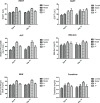In Vitro and in Vivo Studies of pH-Sensitive GHK-Cu-Incorporated Polyaspartic and Polyacrylic Acid Superabsorbent Polymer
- PMID: 31815212
- PMCID: PMC6893953
- DOI: 10.1021/acsomega.9b00655
In Vitro and in Vivo Studies of pH-Sensitive GHK-Cu-Incorporated Polyaspartic and Polyacrylic Acid Superabsorbent Polymer
Abstract
The main aim of this study was to evaluate the in vitro and in vivo efficiency of the polyaspartic acid- and acrylic acid-based superabsorbent polymer. The synthesized polymer was first investigated to check the blood compatibility by protein adsorption and blood clotting tests. Further, the GHK-Cu peptide was incorporated within the polymer and release studies were performed to evaluate the drug-delivery efficiency of the superabsorbent polymer. The polymer with best peptide release results were further used for in vivo analysis for wound healing. The healing efficiency of polymer with and without peptide was analyzed using wound closure, biochemical assay, histopathological, and toxicity studies.
Copyright © 2019 American Chemical Society.
Conflict of interest statement
The authors declare the following competing financial interest(s): The financial funding was provided by University of Grant Commision, New Delhi, India (Grant No: F.No. 42-255/2013 (SR)).
Figures









Similar articles
-
Polyaspartic acid, 2-acrylamido-2-Methyl propane sulfonic acid and sodium alginate based biocompatible stimuli responsive polymer gel for controlled release of GHK-Cu peptide for wound healing.J Biomater Appl. 2022 Jul;37(1):132-150. doi: 10.1177/08853282221076708. Epub 2022 Mar 26. J Biomater Appl. 2022. PMID: 35341370
-
Biotinylated GHK peptide incorporated collagenous matrix: A novel biomaterial for dermal wound healing in rats.J Biomed Mater Res B Appl Biomater. 2005 May;73(2):383-91. doi: 10.1002/jbm.b.30246. J Biomed Mater Res B Appl Biomater. 2005. PMID: 15803494
-
Enhanced biological properties of collagen/chitosan-coated poly(ε-caprolactone) scaffold by surface modification with GHK-Cu peptide and 58S bioglass.Prog Biomater. 2020 Jun;9(1-2):25-34. doi: 10.1007/s40204-020-00129-0. Epub 2020 Apr 4. Prog Biomater. 2020. PMID: 32248401 Free PMC article.
-
The human tri-peptide GHK and tissue remodeling.J Biomater Sci Polym Ed. 2008;19(8):969-88. doi: 10.1163/156856208784909435. J Biomater Sci Polym Ed. 2008. PMID: 18644225 Review.
-
Regenerative and Protective Actions of the GHK-Cu Peptide in the Light of the New Gene Data.Int J Mol Sci. 2018 Jul 7;19(7):1987. doi: 10.3390/ijms19071987. Int J Mol Sci. 2018. PMID: 29986520 Free PMC article. Review.
Cited by
-
Ternary Cu(II) Complex with GHK Peptide and Cis-Urocanic Acid as a Potential Physiologically Functional Copper Chelate.Int J Mol Sci. 2020 Aug 27;21(17):6190. doi: 10.3390/ijms21176190. Int J Mol Sci. 2020. PMID: 32867146 Free PMC article.
References
-
- Sharma S.; Dua A.; Malik A. Third generation materials for wound dressings. Int. J. Pharm. Sci. Res. 2014, 5, 2113–2124.
-
- Singh S.; Young A.; McNaught C. E. The physiology of wound healing. Surgery 2017, 35, 473–477. 10.1016/j.mpsur.2017.06.004. - DOI
-
- Johnson C. Management of Burns. Surgery 2018, 36, 435–440. 10.1016/j.mpsur.2018.05.004. - DOI
LinkOut - more resources
Full Text Sources

